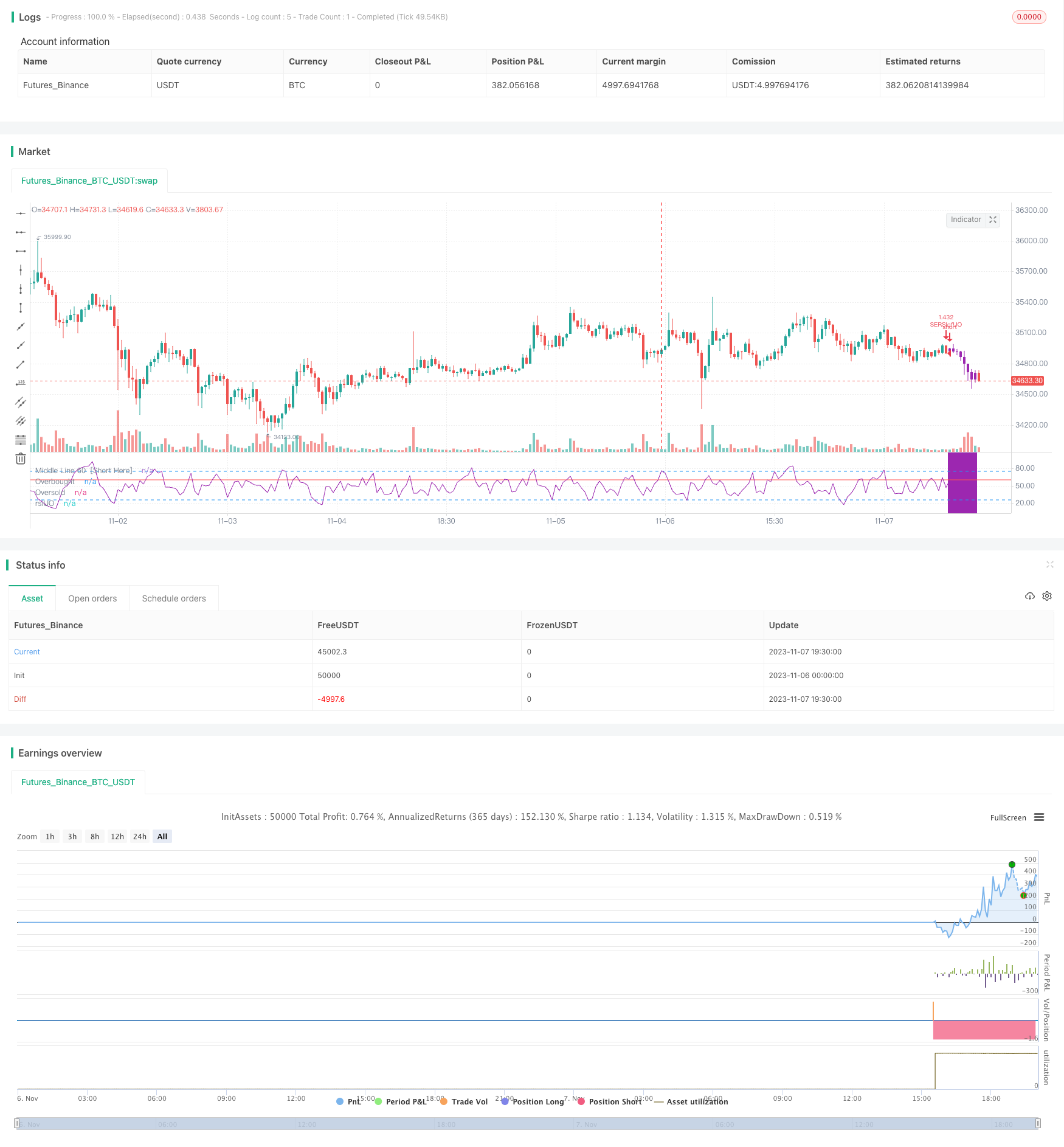
概述
该策略是一种利用RSI指标进行短线交易的策略。它结合RSI指标和威廉姆斯鳄鱼指标,在RSI指标进入超买或超卖区域时进行反向交易,属于较为保守的短线交易策略。
策略原理
该策略主要基于以下几点原理:
使用海龟交易法则,只在市场明显反转时才入场,采取较保守的交易方式。
使用RSI指标判断市场超买超卖现象。当RSI指标线进入超买区(默认为60分界线以上)或超卖区(默认为40分界线以下)时,表示市场处于反转的临界点,这时进行反向交易。
结合威廉姆斯鳄鱼指标判断市场趋势。只有在鳄鱼指标显示三条均线(红唇线、白牙线、蓝颚线)向下排列时才考虑做空;只有在鳄鱼指标显示三条均线向上排列时才考虑做多。
采用RSI指标的RSI来判断RSI指标本身的超买超卖现象,形成双重过滤效果。只有RSI指标线进入超买超卖区,同时RSI指标的RSI也进入超买超卖区时,才会发出交易信号。
设定止损线和止盈线。当价格翻转达到止盈线或止损线时,平仓止盈或止损。
优势分析
该策略具有以下优势:
采用稳健的海龟交易策略,只在市场明显反转时才入场,可以避免交易市场震荡时无方向的巨大风险。
使用RSI指标判断市场反转点,指标简单明了,容易操作。RSI的RSI设置避免了whipsaw,双重过滤提高了信号的可靠性。
结合鳄鱼指标判断趋势方向,避免逆势交易。鳄鱼指标作为辅助条件增加了过滤效果。
设置止盈止损策略,可以锁定盈利,控制风险。
易于参数优化。RSI的参数以及进场出场条件可以根据不同市场调整,优化策略。
风险分析
该策略也存在一些风险:
RSI指标发出假信号的概率存在。RSI指标可能会发出错误的超买超卖信号。结合鳄鱼指标可以降低假信号概率。
止损点设置过大可能导致亏损扩大。应适当缩小止损点,降低单笔损失。
反转不一定发生在RSI超买超卖区。市场结构变化可能导致反转点变化,应适时调整参数。
交易次数可能较少,存在长时间无交易的情况。可适当宽松进场条件以增加交易次数。
市场可能长期持续上涨或下跌,使短线交易受困。应适时调整持仓周期,延长或缩短交易周期。
优化方向
该策略可以从以下几个方向进行优化:
优化RSI的参数,调整超买区和超卖区的区间,适应不同市场。
调整鳄鱼指标的参数,优化判断趋势方向的准确性。
优化止盈止损的设置,实现最大回撤控制和锁定更多盈利。
结合其他指标等进行组合,提高信号准确性,例如KDJ,MACD等。
增加自动止损,跟踪止损功能,更好控制单笔亏损。
优化仓位管理,不同市场条件下调整仓位大小,控制风险。
优化交易时间段,在趋势更明显的时间段进行交易。
总结
该策略整体来说是一个较为稳健的短线交易策略。它采用较为保守的海龟交易策略,同时利用RSI指标判断反转点,并辅以鳄鱼指标判断趋势方向,可以有效避免追高杀跌之类的高风险交易,锁定较为稳定的盈利。通过优化参数设置、止盈止损策略、组合其他指标等手段,可以不断提升该策略的效果。总体来说,该策略适合对市场反转交易感兴趣、追求稳定收益的投资者。
/*backtest
start: 2023-11-06 00:00:00
end: 2023-11-07 20:00:00
period: 30m
basePeriod: 15m
exchanges: [{"eid":"Futures_Binance","currency":"BTC_USDT"}]
*/
// This source code is subject to the terms of the Mozilla Public License 2.0 at https://mozilla.org/MPL/2.0/
// © mohanee
//@version=4
strategy(title="RSI of Ultimate Oscillator [SHORT Selling] Strategy", shorttitle="RSIofUO" , overlay=false, pyramiding=1, default_qty_type=strategy.percent_of_equity, default_qty_value=20, initial_capital=10000, currency=currency.USD) //default_qty_value=10, default_qty_type=strategy.fixed,
//Ultimate Oscillator logic copied from TradingView builtin indicator
/////////////////////////////////////////////////////////////////////////////////
length1 = input(5, minval=1), length2 = input(10, minval=1), length3 = input(15, minval=1)
rsiUOLength = input(5, title="RSI UO length", minval=1)
sellLine = input (60, title="Sell at RSIofUO")
coverLine = input (75, title="Cover at RSIofUO")
riskCapital = input(title="Risk % of capital", defval=10, minval=1)
stopLoss=input(3,title="Stop Loss",minval=1)
showUO=input(false, "show Ultimate Oscialltor")
average(bp, tr_, length) => sum(bp, length) / sum(tr_, length)
high_ = max(high, close[1])
low_ = min(low, close[1])
bp = close - low_
tr_ = high_ - low_
avg7 = average(bp, tr_, length1)
avg14 = average(bp, tr_, length2)
avg28 = average(bp, tr_, length3)
out = 100 * (4*avg7 + 2*avg14 + avg28)/7
//Ultimate Oscillator
/////////////////////////////////////////////////////////////////////////////////
//Willimas Alligator copied from TradingView built in Indicator
/////////////////////////////////////////////////////////////////////////////////
smma(src, length) =>
smma = 0.0
smma := na(smma[1]) ? sma(src, length) : (smma[1] * (length - 1) + src) / length
smma
//moving averages logic copied from Willimas Alligator -- builtin indicator in TradingView
sma1=smma(hl2,10)
sma2=smma(hl2,20)
sma3=smma(hl2,50)
//Willimas Alligator
/////////////////////////////////////////////////////////////////////////////////
//drawings
/////////////////////////////////////////////////////////////////////////////////
hline(sellLine, title="Middle Line 60 [Short Here]", color=color.red , linestyle=hline.style_solid)
obLevelPlot = hline(75, title="Overbought", color=color.blue , linestyle=hline.style_dashed)
osLevelPlot = hline(25, title="Oversold", color=color.blue, linestyle=hline.style_dashed)
fill(obLevelPlot, osLevelPlot, title="Background", color=color.blue, transp=90)
rsiUO = rsi(out,rsiUOLength)
ultPlot=plot(showUO==true? out : na, color=color.green, title="Oscillator")
plot(rsiUO, title = "rsiUO" , color=color.purple)
//drawings
/////////////////////////////////////////////////////////////////////////////////
//Strategy Logic
/////////////////////////////////////////////////////////////////////////////////
//Entry--
//Echeck how many units can be purchased based on risk manage ment and stop loss
qty1 = (strategy.equity * riskCapital / 100 ) / (close*stopLoss/100)
//check if cash is sufficient to buy qty1 , if capital not available use the available capital only
qty1:= (qty1 * close >= strategy.equity ) ? (strategy.equity / close) : qty1
strategy.entry(id="SERSIofUO", long=false, qty=qty1, when = sma1<=sma2 and sma2 < sma3 and close<sma2 and crossunder(rsiUO,sellLine) )
//strategy.entry(id="SERSiofUO", long=false, when = sma1< sma2 and crossunder(rsiUO,60) )
barcolor(abs(strategy.position_size)>=1 ? color.purple : na )
bgcolor(abs(strategy.position_size)>=1 ? color.purple : na , transp=70)
//partial exit
strategy.close(id="SERSIofUO", comment="PExit", qty=strategy.position_size/3, when=abs(strategy.position_size)>=1 and close< strategy.position_avg_price and crossover(rsiUO,30) )
strategy.close(id="SERSIofUO", comment="CloseAll", when=abs(strategy.position_size)>=1 and crossover(rsiUO,coverLine) )
//Strategy Logic
/////////////////////////////////////////////////////////////////////////////////